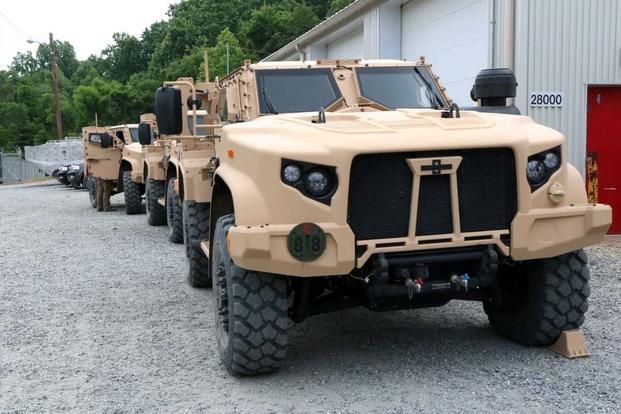The U.S. military's new Joint Light Tactical Vehicle suffers from reliability, safety and lethality shortcomings that need fixing before it will be suitable for battlefield use, according to a recent Defense Department test and evaluation report.
Army and Marine Corps units will soon start training with the JLTV, a high-performance vehicle designed to replace many of the military's aging Humvees.
The JLTV is intended to provide increased mobility and crew protection for combat units, but program officials should develop plans to fix problems, such as a lack of crew situational awareness, maintenance issues and other deficiencies that could hinder combat performance, according to the Fiscal 2018 Annual Report from the Defense Department's Director for Operational Test and Evaluation.
"All JLTVs are not operationally suitable because of deficiencies in reliability, maintainability, training, manuals, crew situational awareness, and safety," the report states. "JLTVs demonstrated less reliability than its requirement. The primary drivers of operational mission failures were engine wiring problems, flat and damaged tires, and brake system faults."
To be fair, the JLTV Multi-Service Operational Test and Evaluation report submitted to Congress in October 2018 wasn't all bad, the newest report states.
"The Army and Marine Corps units equipped with the JLTVs accomplished 17 of 24 major combat and wide-area security missions," the report states. "The majority of unsuccessful missions were attributed to combat losses. The single non-successful mission attributed to the JLTV was due to reliability failures."
Marine Corps units using JLTVs can accomplish shore-to-shore amphibious operations on a non-contested beach, as well as accomplish air assault missions with more-protective B-kit armor attached to "counter threat activities at the landing zone," according to the report.
Army units equipped with JLTVs can accomplish air assault missions but must do so without extra B-kit armor because the extra weight makes them too heavy to be sling-loaded by CH-47F Chinook helicopters, the report states.
However, the JLTV's Close Combat Weapons Carrier variant is in some cases less effective than the older Humvee equipped with Tube-launched, Optically tracked, Wire-guided (TOW) missiles, it adds.
"The CCWC is not operationally effective for employment in combat and tactical missions, according to the report. "The CCWC provides less capability to engage threats with the TOW missiles over the [Humvee]. The missile reload process is slow and difficult for crews. The CCWC has less storage space than other JLTV variants, and accessing mission-essential equipment from the cargo area is a challenge."
JLTV program officials plan to implement corrective actions to the CCWC variant to improve its effectiveness with TOW missiles and investigate solutions to improve missile reload prior to fielding to Army and Marine units, the report states.
The JLTV also suffers from safety shortcomings, according to the report.
"Crew has poor visibility due to blind spots around the vehicle," it states. "Crews had slow egress from JLTVs, and numerous reliability failures of doors not opening impeded the ability of the soldiers and Marines to safely ingress and egress the JLTV."
The size and sound of the JLTV may present problems since it has a "large visual and loud aural signature, increasing detectability," the report states.
The new JLTVs are also causing some maintenance headaches. Units cannot maintain the JLTV without support from contractor field service representatives "due to vehicle complexity, ineffective training, poor manuals, and challenges with troubleshooting the vehicle," according to the report.
Program officials plan to revise the maintenance course content, ensure units receive more training and supplement unit maintainers with on-site field service representatives as part of JLTV fielding, it states.
The Army plans to buy about 49,099 JLTVs, while the Marine Corps intends to buy about 9,091, the report states. The Air Force plans to buy 80 JLTVs.
-- Matthew Cox can be reached at matthew.cox@military.com.









